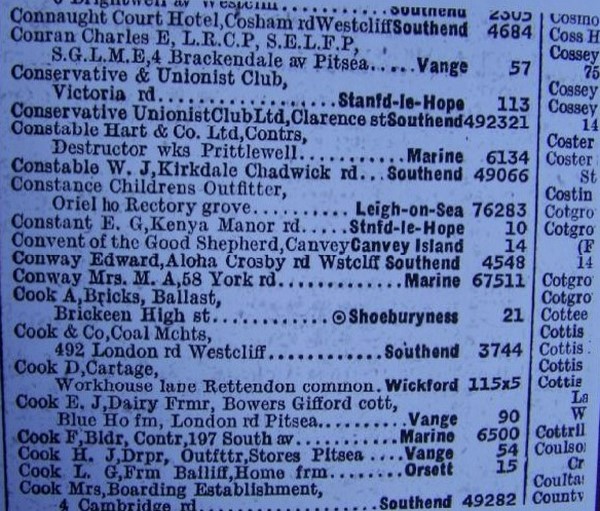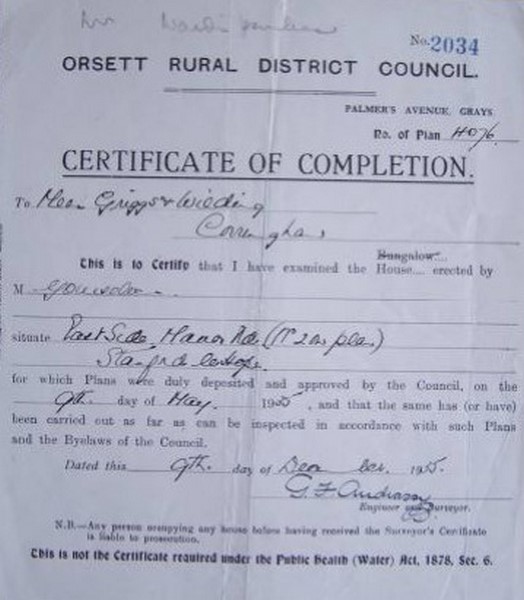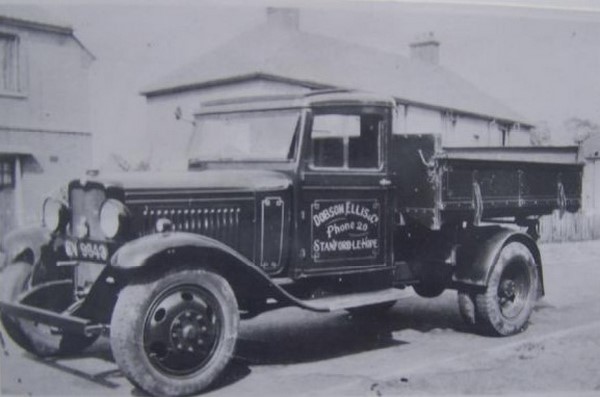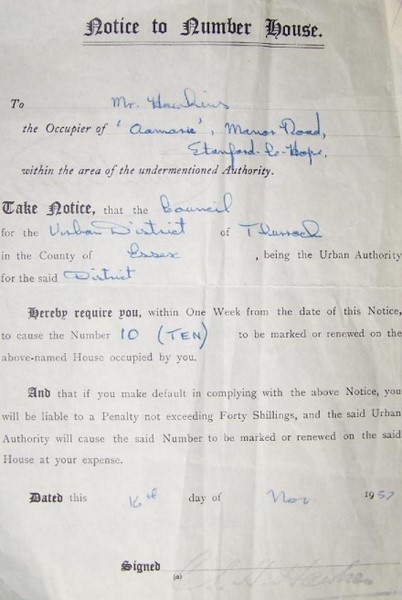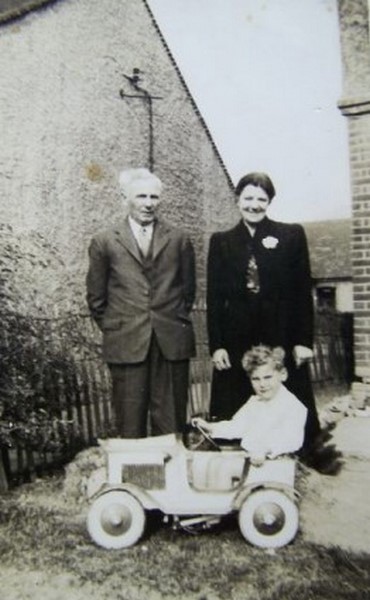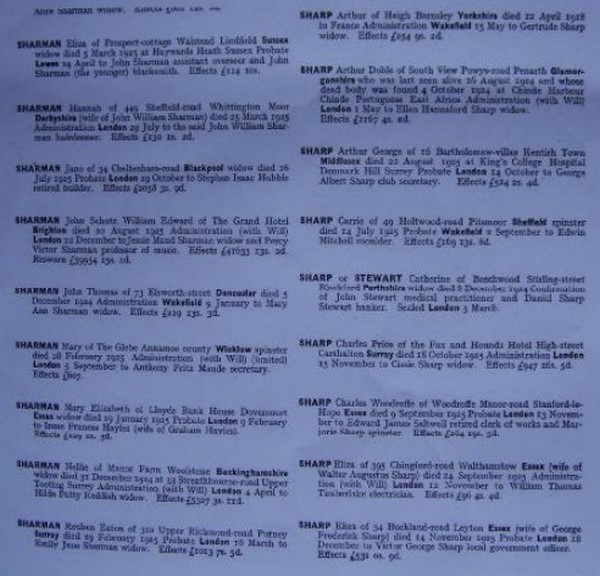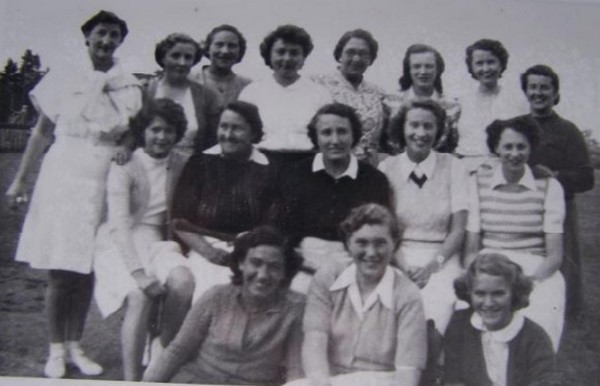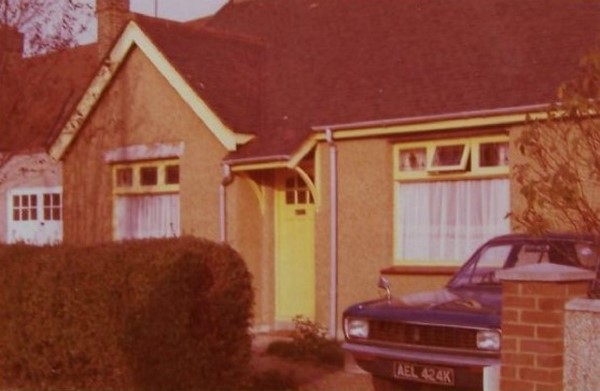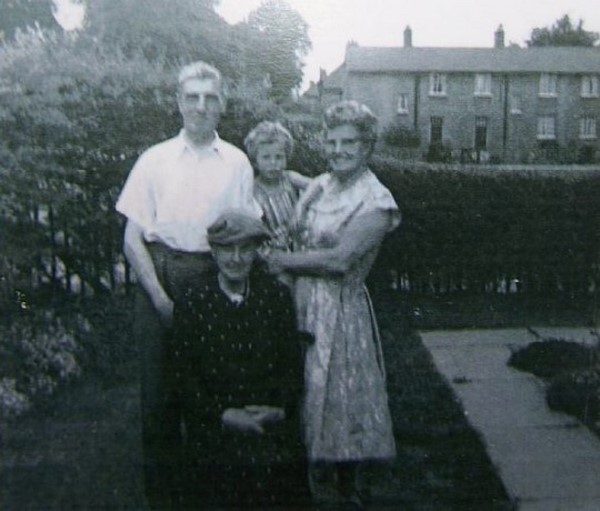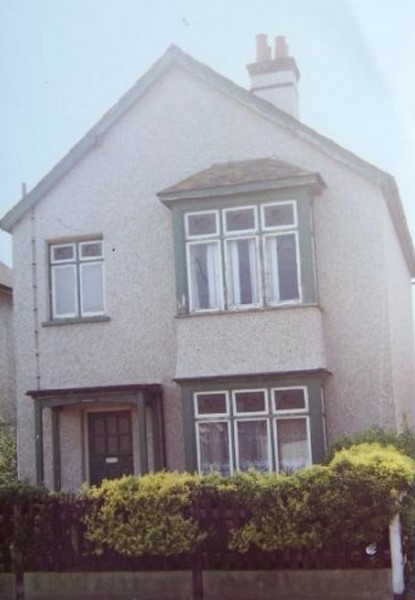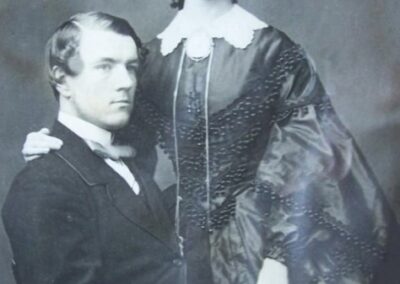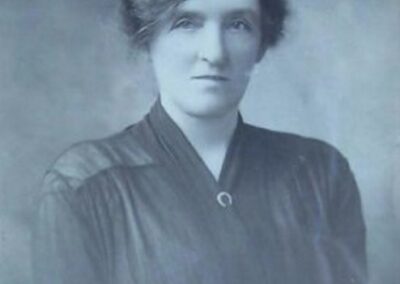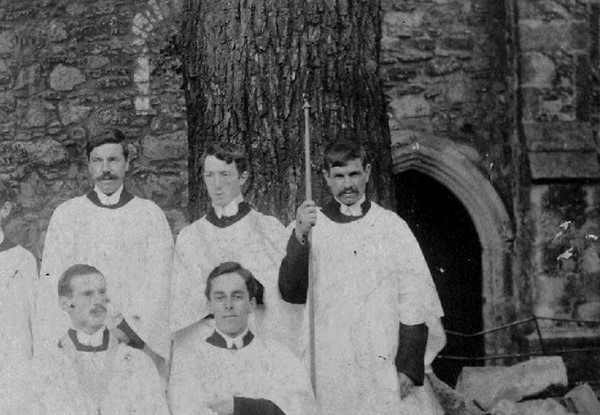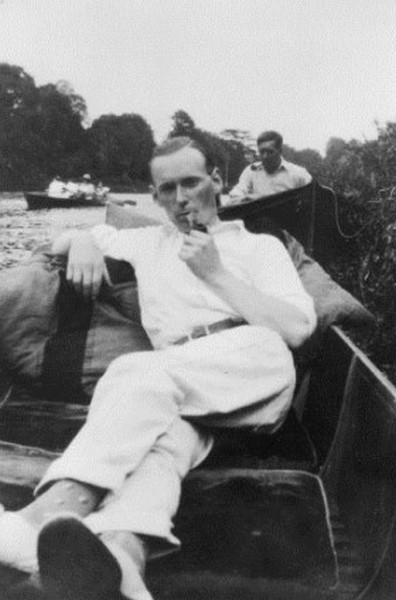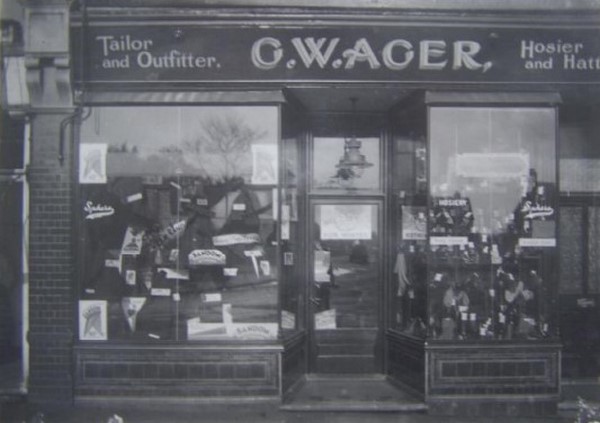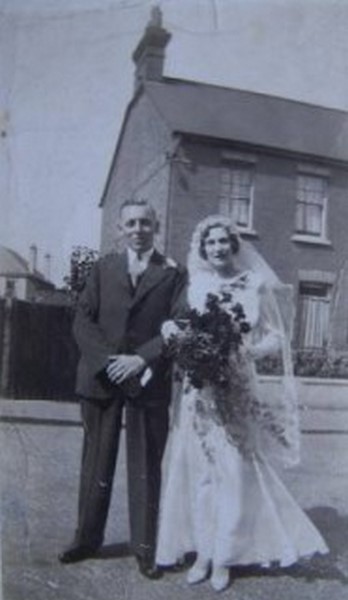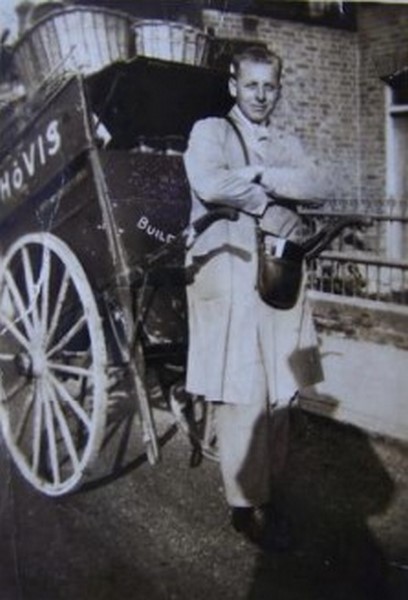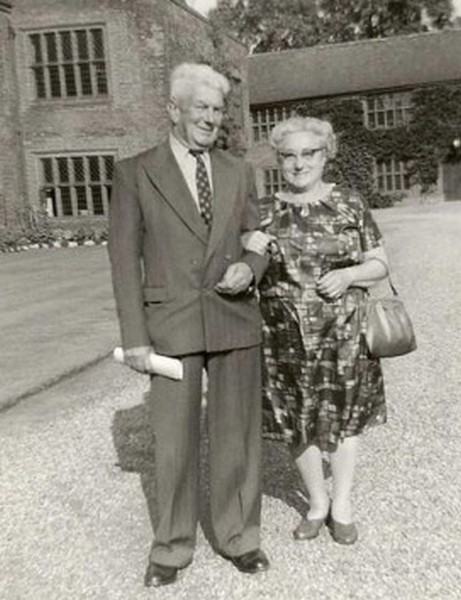Manor Road
As with the other roads on the estate, the land fronting Manor Road was parcelled into strips measuring approximately 20 feet x 145 feet which were offered for sale at a cost of about £40 each. The plots were sold mainly in pairs to private individuals and also to local builders, prominent amongst whom were Thomas Wilding of 8 Poley Road and his associate Frederick Arthur Griggs of ‘Allendale’ High Road Fobbing who had moved there from Salisbury Avenue. The local Agent for the General Property Trust Company was Walter Tyrrell of ‘St Peter’s’ Horndon-on-the-Hill (telephone Stanford-le-Hope 4) and he dealt with most of the early land sales in the road on their behalf.
It appears that the Company intended that the development of the Central Building Estate should be what is known today as upmarket, as there was a stipulation in the original conveyances as to the minimum value of the houses to be constructed which was set at a fairly high level for the pre and post First World War period.
All of this is in contrast with what would happen today if a parcel of land such as the Central Building Estate became available with outline planning permission for residential development. It would be bought quickly by one of the big house building firms whose aim would be to erect a densely packed estate of houses and flats, with of course no bungalows, based on a few standardised designs of the type that can be seen anywhere in the country.
Manor Road remained an unmade track for many years. Under the terms of the original land conveyances the residents were obliged to make or pay for repairs to their frontage on the often potholed track using whatever materials there were to hand such as ash and clinkers from the coal fires. In the early days it is likely that most people travelled around by bus, bicycle or on foot, but with greater car ownership particularly after the Second World War the state of the road must have become of increasing concern.
By 1967 plans had been put in place by Thurrock Urban District Council for the road to be adopted and made up with street lighting installed. The residents were required to make a contribution to the cost of the works in proportion to the frontage of their plots to the road.
As these contributions were considerable amounts for many people the Council accepted payment by instalments over a period. The consulting engineer appointed by the Council was Sir Frederick Snow and Partners and the works went ahead in 1970 resulting in the layout we are familiar with today.
Walter Tyrrell was the local agent for the General Property Trust Company.
This is a letter dated March 23rd 1926 to Philip Hildro Evans, then living in Teddington, Middlesex,
The parcel of land as shown on the deeds for the houses in Manor Road was known as Coblers Field and was sold by
Elizabeth Scratton to Ambrose Ellis in 1896. The dimensions given (in feet and inches to whole feet) equate to an area of
11 acres 2 roods and 25 perches, about 4.8 hectares in metric land measure. Immediately to the west are Two Acre Field
and Three Acre Field which with Coblers Field made up the area of the Central Building Estate.
Utilities in Manor Road
Water, gas, telephones, and main drainage were available fromthe outset but an electrical supply was not to follow until the early 1930s. The early houses had gas or oil lamp lighting perhaps using the ‘Famus’ Oil Lamp (Better Light at Half the Cost) available from Horncastles for 42/- (Shillings) or two Guineas.
Main drainage was planned as part of a major works scheme for which discussions between the parish councils of Stanford; Mucking; and Horndon with the Orsett Union began in 1909. The original boundaries of these parishes were at the bridge over the Hassing Brook in London Road and the north side of London Road. For practical purposes it was decided that as the execution of the scheme would involve all three parishes it would best be handled by the one most involved which was Stanford. The boundary of the Stanford parish was therefore enlarged by an agreement of 1910 establishing that which remains to this day. After much delay in obtaining the funds for the scheme caused partly by the late addition of the Balstonia Estate, it finally went ahead in 1912-13. The drainage scheme was therefore in place well before any houses were built in the road.
In 1898 a company was incorporated to supply Stanford with gas and capital raised to construct a works but the scheme was abandoned and the capital returned to the investors. A rival scheme to bring electricity to the parish proposed by an electrician who had settled in the village, attracted much interest and he obtained a contract with the parish council to proceed. However his backer, Mr. Morley Hill, actually failed to provide any financing with the result that the scheme foundered and the electrician disappeared. Stanford village accordingly remained unlit in the winter months until a few oil lamps were installed which were used from 1st September each year.
The scheme to provide a gas works was revived in 1905 but construction did not begin until 1908 with the plant opening in Butts Road on September 7th 1909. The new company was awarded a contract with the parish council to provide 80 Bray’s Incandescent upright burners which were ceremonially bought into use on the opening day.
The Stanford Gas company remained independent until 1913 when it was taken over by the Grays and Tilbury Gas Company. The Grays and Tilbury was a pioneer of what was then high pressure gas transmission at 50psi (about 3.4 bar) and supplied gas by pipeline from their works in London Road Grays to the offtake in Butts Road with the original gas manufacturing works there subsequently being closed. They also supplied areas of Laindon, Billericay; and Rayleigh. The Grays and Tilbury Gas Company was in turn absorbed by the much larger Gas Light and Coke Company in 1930 along with another local undertaking in Pinner, Middlesex. The Gas Light and Coke continued to expand through Essex during the 1930s and at the time of nationalisation after the Second World War formed the then North Thames Gas Region of the British Gas Corporation, now the North London Distribution Zone of the National Grid Company.
When an electrical supply was finally made available circa 1932 in Stanford by the County of London Electric Supply Company,7 as was usual in rural locations in the early days of electrical distribution the power was, and still is in Manor Road and elsewhere in the area, supplied by an overhead system supported by wooden poles. Today such a system is known as ‘TT’ denoting the type of electrical earthing arrangement. The four wires visible are the three electrical phases, designated brown, black, and grey (formerly red, yellow and blue) and the neutral designated light blue. The distribution network operator balances the load on the phases by linking about one third of the houses in the road to each of the three. Unlike the more usual underground supply in the area known as ‘TN-S’ that provides the consumer with an earth connection via the cable armouring, the TT system does not, nor is the distribution network operator obliged to provide one. It is up to the consumer to ensure that there is an adequate earth connection to the earth busbar with a residual current device protection for the installation. As an alternative, providing metalwork bonding requirements in the domestic installation are met, the distribution network operator can convert the supply to a modern TNC-S or protective multiple earth system where the consumer’s earth connection is bonded to the neutral of the supply.
Telephone services were provided by the then GPO but were a rarity in private houses in the 1920s and 1930s. In 1930 the only telephone subscribers in the road were Edgar George Constant at Kenya (Stanford-le-Hope 10) and Philip Hildro Evans at Coomehurst (Stanford-le-Hope 137) and even by 1938 there appeared to be only two other subscribers, Reginald Lewis Bretton Hawkins at Oamaru (Stanford-le-Hope 141) and Eric Fay at End House (Stanford-le-Hope 259). When new residents moved in to these properties they did not often take the opportunity, if there was one, to retain the telephone lines thus for example when Edgar Constant left the house he named Kenya in 1933 the next residents Alfred and Elsie Barber, who renamed it Wyngarth were not listed in subsequent directories.
When the first houses were built in the road some at least had outside toilets and at night time the residents would have had to have made use of chamber pots. ‘Tin’ or ‘bungalow’ baths may also have been in use in some of the earlier dwellings. Central heating was virtually unknown outside public buildings and large upper class homes and the houses in the road would have their rooms heated by open fires in grates. What these early residents would have made of the comforts we take for granted today is a matter for speculation and who knows what amenities those who follow us may additionally enjoy. A few of us however may remember our own childhood in the 1950s that perhaps were not too much different in some respects from these earlier times!
The Houses
The houses in Manor Road were erected by local builders of whom there were a number in the area over a period of about fourteen years from around 1923. Architectural fashions changed somewhat over the period with bowed bay front windows rather than the straight rectangular type of bay becoming more popular over time.
Entries from a telephone directory of 1930 with Edgar George Constant listed at Kenya
These variations help give the road much of its variety and interest. Notable too are the flat roofed houses at the corner just in Corringham Road. These are based on the ‘Moderne’ style that became fashionable in the early 1930s following the construction in Amersham, Buckinghamshire of a remarkable house called ‘High and Over’. This airy and impressive house, built in the shape of a ‘Y’, was originally intended to be built of reinforced concrete and has a flat roof and large metal framed windows. It has featured in television series set in the 1930s such as ‘Poirot’ and whilst it once stood in its own grounds, modern development has taken place to its boundaries. The houses in Corringham Road were used by the Shell Oil Company for its office staff during the Second World War and the garages just in Manor Road were used as a pay office for the workers. Prior to that the house directly on the corner of Manor Road had been the home of George Boyce who with his brother Bill had built and run the Regent Cinema in Corringham Road which opened on Monday 18th February 1935.
Methods of house construction changed as well. It was common until the 1930s for houses to be built with the decorative Flemish bond brickwork style to give a double thickness load bearing wall. In this style bricks are laid alternately with their long or stretcher side with the short or header side. In the next course the headers are centred above the stretchers below with the second thickness thus forming the bond. Later houses used the much more familiar running bond where only stretchers are seen with each course of bricks overlapping midway to the one below. As this gives only a single thickness of wall, a second inner course is constructed with ties between the two to bear the loads. This gives a cavity between the two leaves that can be filled with insulating material.
There were few modern aids to building in the 1920s and 1930s and footings had to be laboriously dug by hand rather than by the mechanical bucket excavators in use today. For this reason it was usual to dig down to a level where the ground was solidly compacted and build up the footings from there.
Griggs and Wilding Builders built twelve of the houses but it has not been possible to determine for certain who built the others as the originals of the completion certificates that would have been issued by the parish council or by the land company’s surveyors seem, most unfortunately, to be no longer in existence as they are not in Thurrock Council’s archives. These would have given the final completion date and the builder’s name.
Other builders operating in the 1920s and 1930s included L.E.Brand (Builders and Undertakers) Wharf Road; H.E Davisson; Dobson & Son London Road; J.M. Sullings of Copeland Road and later Southend Road; R.E.Watts Southend Road; and C.Yates & Son Southend Road.
When a house was completed the builder welcomed his client to their new property by flying a Union Flag from the chimney. This was an invitation for the client to ‘stand a round’ for the builder and his workmen!
With regard to Dobson & Son builders, the following is a personal communication received from Mr. Martin Reeves that is reproduced here with his kind permission;
“This is becoming a rather fascinating story! I will give you a little more information about John Dobson first as this is maybe more relevant to your primary search for the builder of your house. He was born in Barling near Southend in 1865. Was originally a carpenter and later became a builder. He built the chalet bungalow St Osyth, in about 1905 and lived there for many years
Letter from Griggs & Wilding Builders to Leonard Ward dated 1935
Typical copy of a house completion certificate. This one is dated 1935 and would have been
One of the last to be issued by Orsett Rural District Council as Thurrock Urban District Council
I would love to know why he called it St.Osyth as his previous house in Southend he called St.Osyth too. I was fortunate to be able to go around the place in 1980 when I first took an interest in family history. I was taking some photos of the outside when the owner kindly invited me in for a look inside the property. My grandmother told me that John Dobson had been responsible for the building of the Catholic Church, the former Stanford laundry in Poley Road, Allens (the hauliers) repair shop in Victoria Road, a house for the then manager of Shell Haven Refinery, Nicolas Anfilogoff, in about 1920 (but not sure where this was) and also probably some or all of the houses on the left hand side of Scratton Road. One of these houses was for his daughter Ellen and son-in-law William Ellis. William ran a sand and gravel business with John Dobson and extracted from a pit in what is now, I think, a playing field at the end of your road! The pit was in operation for some time before being filled in (when?) I recently saw on the net a reference to archaeological finds from the Dobson and Ellis Pit in Stanford. In the late 1930s John Dobson and his wife, Harriet lived at the house at the junction of Barstable Road and Corringham Road (eastern side). I assume he had it built for himself but am not certain. He called the house “Messines” – so named because their eldest son, Arthur John, was an RFC pilot killed in action at Messines, Belgium in June 1917. Maybe his firm could have been called Dobson and Sons-in-law because neither of his sons was involved in the business but his sons-in-law were, William Ellis as mentioned, and Arthur William Deed (b1888) (my grandfather.) My grandfather too started as a carpenter before becoming a builder. He worked in partnership with John Dobson until about 1920 when he started as a building contractor on his own account. He was responsible for building much of Caldwell Road and some bungalows on the Southend Road (north of the now Manorway). He continued as a builder in the Stanford area until about 1938 when he moved his business to Upminster. So although sadly I have no details about the building of houses in Manor Road it is possible that your house was built by John Dobson alone or in partnership with Arthur Deed or by my grandfather alone!”
The house ‘St Osyth’ that John Dobson built in Stanford and referred to by Mr.Reeves is in Park Road. Also the house ‘Messines’ he writes of is, according to information received from long time residents of the area, actually that on the eastern corner of Manor Road and Corringham Road, later named Argyll House, the name that it bears today. John Dobson was also responsible for the construction of the buildings for Stanford Gas Works in Butts Road. (q.v.)
A Dobson and Ellis sand and gravel delivery lorry.
Nicolas Anfilogoff, born in Latvia in 1875, was a brilliant chemical engineer who moved to the UK in 1894 and designed and supervised the construction of the UK’s first oil refinery at Thames Haven in 1908. He went on to be the manager there as Mr.Reeves mentioned. Nicolas Anfilogoff lived in Lathol House, (London And Thames Haven Oil wharves Limited) Thames Haven, which was situated with others between the No.s 1 and 2 gates of the former Shell Haven refinery. As a prominent local citizen, Mr.Anfilogoff also served as vice-chairman of Stanford Parish Council.
When the houses were built in Manor Road it was necessary for the owners to identify them particularly when further building took place in the late 1920s and 1930s. By the 1930s numbers were beginning to be used with the usual arrangement of odd numbers to the left side of the road and even numbers to the right as viewed going away from the town centre. An Act of Parliament, the Stamp Act of 1765, had decreed that in certain areas houses were to be numbered with a name added if desired, but this was not generally enacted and even today there are areas where houses have only names. The house numbers were not officially required to be displayed in Manor Road until the 1950s at which time ‘notice to number house’ documents were issued to the residents by the then Thurrock Urban District Council. By means of the official notice the 23 Council gave the residents one week on pain of a forty shilling (£2) fine ‘to cause the number to be marked or renewed on the above named house occupied by you.’ Before then as already indicated the owners gave the houses names some of which are rather obvious being based on the owner’s names or named after locations known to them, but others, after this passage of time, are quite obscure. Although the official notice issued by the council did not state that the house name was to be removed, just the number displayed, as in the rest of Stanford the names appear to have generally fallen into disuse after these notices were issued.
The position today is that once officially issued the number becomes the address of the property and cannot then be replaced by a name, but of course this does not preclude the addition of a name to the number on a plaque, particularly an original, and the householder is free to do so. The name can be officially added to the house number address only by contacting Thurrock Council who will check the name and make the necessary arrangements with the various departments and the Post Office.
The Residents to 1940
By searching publicly available documents and records and using genealogy web sites, it has been possible in most cases to trace the early residents of the road, particularly where it has been possible to contact living relatives many of whom have actively traced their family trees and who like Mr.Reeves have been willing to share their knowledge. In other cases, particularly with records prior to 1915, it has proved difficult to find unambiguous information especially where fairly common surnames are involved, or in some instances any at all, so the following accounts have varying degrees of detail.
More information can be obtained by consulting census records but these are embargoed for one hundred years so that the records for 1911 are only just now becoming available. As an aside it is interesting to note that the complete record of the 1931 census was destroyed in a fire at a store at Hayes, Middlesex in 1942 that was due to an accident and not enemy action. Owing to the Second World War there was no census carried out in 1941.
Manor House No.1
Manor House was built circa 1923 by Thomas Wilding for his own family in association with his business partner Frederick Arthur Griggs. Thomas Wilding was born in Latchingdon in 1884 the son of Charles and Julia Wilding nee Challis.
Official notice to number house issued to Lewis Hawkins in 1957.
Map of Manor Road showing the house names in 1938. The houses and plots as shown on this map are representations of reality only.
The family moved to Runwell and then to Dunton Road in Laindon where at the age of 17 Thomas was employed as a builder’s labourer. In 1913 at the age of 28 he married Gertrude Eva Harvey, a dressmaker, who was born in Billericay in 1886 the daughter of William and Rosa Jane Harvey and by 1918 Thomas and Gertrude were living in Poley Road. They had three children two of whom unfortunately did not survive and Gertrude herself died in 1920 at the age of only 34. Thomas, then of course a widower, married Lily Strange who was born in Deptford Kent in 1898 the daughter of Thomas and Mary Strange, in Hatcham Lewisham in 1921. Thomas was now in partnership as a builder with Frederick Arthur Griggs as ‘Griggs and Wilding Builders’. Thomas and Frederick went on to build eleven more houses in the road in addition to Manor House as well as others elsewhere. Thomas died in 1944 at the age of 60 and Lily, who continued to live at Manor House, in 1975 at the age of 77.
Thomas and Lily Wilding with their son Ronnie
Woodroffe No.2
Woodroffe, built by Griggs and Wilding in 1924, was with Manor House, one of the first dwellings in the road and it changed hands several times between then and the outbreak of the Second World War. The first residents were Charles Woodroffe Sharp and his wife Amy Francis Sharp. Charles was born in Paddington, Middlesex in 1860, the son of Charles Henry Sharp and Eliza Woodroffe. He and Amy had four children, Charles; Marjorie; Muriel; and Frances and when they moved to Stanford-le-Hope from Hatfield Broad Oak near Bishops Stortford, Marjorie, who was born in 1892 and was thus 33 came with them. Unfortunately Charles, who had been headmaster of Highwood School in Chelmsford and had quickly become popular in the village, died within a few months of settling here on 9th September 1925 at the age of only 64 and Amy died two years later aged 63. Marjorie stayed at Woodroffe until 1928 when the property passed to William Arthur Shead and his wife Elsie Victoria. Marjorie married a Frederick J.W. Stevens in 1933 in the Orsett registration district.
In 1929 Frederick Francis Merchant and his wife Jane Regina Merchant nee Carter came to live with William and Elsie. Frederick had been born in the area in 1904 and he and Jane, who was also local and born in 1907, had married in 1927. They had a daughter and a son whilst living in Manor Road, Eva, born in February 1928 and Eric born in 1929. In 1931 having moved from Woodroffe, they had another daughter, Edna.
Frederick and Jane and William and Elsie had moved by 1930 when Ernest Andrew Wright and his wife Lucy became the new residents. It has proved difficult to trace this couple but in 1932 they were joined by a Douglas Arthur Collow, presumably a lodger, who may have been the Douglas Arthur Collow the records show as having been born in Brentford Middlesex in 1907. Again Ernest and Lucy Wright and Douglas Collow lived at Woodroffe only briefly for in 1933, and only for that year, the occupants were Alfred William Harrod and Edna Doris Harrod.
The house has no residents listed for 1934 but in 1935 and 1936 Joseph Hull Junior, an insurance agent by trade, and Doris Eileen Hull were listed. Joseph and Doris, whose maiden name was Churcher had married at St.John’s Church in Mucking in August 1934, Joseph being 29 and Doris 27 at the time of their marriage. Doris’s mother Edith Mary was also resident but died in 1935 at the age of 60.
By 1937 Joseph and Doris had left with John and Minnie Alves becoming the new residents remaining there until 1939 when John 28 and Queenie May Jackaman arrived with William Albert Bearman, Queenie’s younger brother.
John Jackaman (1892 – 1964) was born in in Rochford and was later employed as a railway clerk whilst living with his parents John and Alice who as a family had moved to Victoria Road in Stanford by 1911. In 1919 he married Queenie May Bearman (1898 – 1971) who was born in Hadfield Road and who was the daughter of Elijah and Julia Ann Bearman who lived to the age of 94.
John and Queenie May moved to Manor Road from Southend Road and had three children, Edward, Vera, and Eric. John and Queenie May Jackaman are buried in Stanford cemetery.
Sylvadene No.3
Sylvadene was built circa 1933 on a plot that had stood vacant between Manor House and Soulby for seven years. The first owners were Lewis James Hardy and Connie Elizabeth Hardy nee Smith, who had moved to Manor Road from St.Thomas Cottage in Victoria Road. Lewis and Connie, married in October 1927 at which time Lewis was 28 and Connie was 25. Lewis worked at Coates Bakers of King Street but other than the fact that Connie was born in 1902 the daughter of Harry Edward Smith and Elizabeth Mary Smith of Haylewood House, Copeland Terrace, Stanford, and that she died in 1973, there is little other information about them to be found other than they had a daughter Sylvia whilst living at Copeland Terrace after whom it is likely they named their house in Manor Road.
Whilst the Hardy family were waiting for Sylvadene to be built they used the plot as an allotment growing a variety of fruits and vegetables.
Kenya/Wyngarth No.4
Kenya was built circa 1926 by Griggs and Wilding and like Woodroffe had a number of occupants between its construction and 1940. The first residents were Edgar George Constant and his wife Mary Constant nee Stanford born in 1900 the daughter of Henry Charles Stanford a ‘Harnessmaker and Ironmonger’ of High Street Stanford, and Elizabeth Stanford. Edgar was born in 1893 in Northfleet Kent the son of Edgar Paul George Constant and Martha Constant nee Irons. Edgar and Mary married in 1925 and took up residence at Mount Pleasant Villa in King Street but soon moved to Manor Road. In 1931 and 32 they were joined at Kenya by Charles Loft Stanford one of Mary’s brothers.
It is not apparent how or if Edgar and Mary chose the name Kenya for their bungalow or if they had reason to call it after the African country of that name.
Apart from Philip Evans at Coomehurst, Edgar Constant was the only telephone subscriber in the road in the 1920s with the number of Stanford-le-Hope 10. Edgar was a car dealer in the area and probably needed the home telephone in connection with his business.
In 1933 the property passed to Alfred Herbert Barber and Elsie Mary Barber nee Ager who renamed it Wyngarth. It has proved difficult to find much information about Alfred Barber other than he was living in a house called ‘Esperance’ in Rochford Road Prittlewell at the time he bought Kenya. Elsie Mary was the daughter of George William Ager and Anna Flora Ager who were well known in Stanford in the 1920s and 1930s as owners of Agers Tailors and Outfitters of the The Green (telephone Stanford-le-Hope 66) whose shop was where Loakmans Hairdresser is currently located trading there until the mid 1970s. Elsie Mary was born in 1898 in Prittlewell where her parents had a drapers shop before relocating to Stanford. Elsie Mary came with her parents to Greenwayes in Manor Road in 1931 (q.v.) so on her marriage to Alfred in 1932 all she had to do was to move along the road!
Probate court record for Charles Woodroffe Sharp who died 9th September 1925.
In 1935, the same year as her father George retired from his business at the age of 65, Elsie and Alfred moved to Midhurst Avenue in Prittlewell where they also named their house Wyngarth. They retained ownership of the Wyngarth in Manor Road as it had become until 1938 when they sold it to Minnie Treston wife of James Edward Treston.
The next occupants of the house who presumably rented it from Alfred and Elsie Barber in 1936 and 1937 were Edwin Broad and Isabella Ada Daisy Broad who was Scottish born. Edwin Broad was born in Herodsfoot Cornwall in 1865 and had been the headmaster at the Kynochtown Public Elementary school, later the Parochial School for over 20 years until 1925 when he retired at the age of 60. In 1901 he was residing at Stanley Villas in Rectory Road although he and Isabella moved several times between then and the time they came to live in Manor Road where they were accompanied by their son John Gillies Sealy Broad. Their daughter, Elizabeth Isabella Ruby Broad, had married Adolphus Felix Pearson in July 1928 at the age of 27.
Edwin Broad died in 1941 at the age of 77 and Isabella in 1950 at the age of 78 their deaths being recorded in Thurrock, far from the places of their birth.
From 1938 the residents were William Duncan Graham, Lillie Graham and William Graham. Unfortunately, and in spite of a search of the records, it has proved difficult to trace these people conclusively.
Soulby No.5
Soulby along with Smardale was built circa 1927 for Joseph Capstick and his son Stanley Reeve Capstick. Joseph was born in 1851 in Islington, north London his father being Francis Capstick who was born in 1810 at Crosby Garrett, Kirkby Stephen, Westmoreland, now in the county of Cumbria, moving to Islington in 1851 the year of Joseph’s birth. Joseph’s grandfather, Edward who was born in Sedbergh, Yorkshire in 1785 moved to Crosby Garrett in 1841. As a young man Joseph spent holidays with his grandfather and with many of his extended family who lived in and around the villages of Soulby and Smardale near Kirkby Stephen.
Joseph was employed on the railway all of his life working his way up from a clerk to stationmaster at Grays in the 1890s and later in the early 20th century at Upminster.
In 1883 at the age of 24 Joseph married Annie Louisa Reeve who was 22 at the time of their marriage. They had two sons, Stanley Reeve Capstick born in 1885 and Cecil Reeve Capstick born in 1891. Joseph and Annie moved house a number of times from Grays to 31 East Ham and later Forest Gate presumably with Joseph’s work. Annie died in 1920 at the age of only 59 and in 1927 at the age of 69 Joseph moved to the house he named Soulby in Manor Road with his brother in law Frank Reeve and Frank’s wife Mary Anne. Frank and Mary stayed with him only for 1927 and subsequently until his death in 1929 Joseph employed a live in housekeeper Ellen Anne Garnish. Also in the house with him in 1928 were Frederick Maurice Wright and in the year of his death John Boggon and William Wright.
Stanford Cricket Club ladies supporters 1951. Grace Muriel Hawkins is fifth from the left in the back row. Her daughterJean is fourth from the left in the centre row and to her left is her friend Mary Crickmer who lived at Soulby. (
The house name Soulby was retained by the next owners Alec Crickmer and his wife Ivy Doris Crickmer who took possession in 1929. Alec was born in 1906 in Billet Lane the son of Harry and Rachel Crickmer nee Peck and had five brothers and three sisters. In 1927 Alec married Ivy Doris Mott who was aged 19 at the time of their marriage. They had two sons and three daughters born between 1928 and 1943. Being a large house Alec’s mother and father Harry and Rachel who had still been living in Billet Lane moved in with him and Ivy and remained with them until 1936. Alec was employed by the Gas Light and Coke Company at its works in Butts Road.
Alec Crickmer died in 1968 and Ivy subsequently remarried and moved from Manor Road.
Editha No.6
Editha, built circa 1925, was the home of Edith Jane Shade until her death in 1968. This picture was taken in 1975 and apart from the spar dashed finish shows the bungalow as Edith would have known it.
Editha was built circa 1925 possibly by Dobson and Son or Arthur Deed, builders of London Road, the first owner being Edith Jane Shade nee Monk.
Edith Jane Monk was born at Brick House in Fobbing in 1874 and was the daughter of James and Sarah Susannah Monk. She had five brothers, James; Thomas; Arthur; Walter; and Lewis of whom more later under the entry for Mablew. Edith married Charles Gentry Shade son of John and Martha Shade nee Gentry, also of Fobbing in 1899. Charles Shade was the village baker in Fobbing until 1918 when he sold the business to his nephew Albert John Deed who continued there until 1932 when he moved the bakery to Lampits Hill. Charles’s brothers Arthur and Herbert were also bakers who ran Shades the Bakers of Gravesend at 13 High Street which remained in business until the 1970s.
Charles and Edith divorced in 1915 after Edith had an affair with Jack Arthur Macaulay, Charles’s assistant at the bakery who was eight years her junior. After her divorce Edith moved hurriedly to Folkestone with Jack Macaulay although she had returned alone to High Road, Fobbing by 1924. Charles married a Harriett Clark in 1918, and on selling his business to Albert in that year, moved to 33 Vange with his new wife where he became a fruit grower. Charles died in 1948 his death being registered in the Brentwood district.
Edith continued to use her former married name, purchasing the building plots in Manor Road in 1924 at the age of 50. On the land deeds she is described as a ‘Feme Sole’ an old legal term for an unmarried woman with legal and property rights. As mentioned previously her bungalow, Editha, may have been built by Dobson or Deeds builders or both in partnership. Arthur Deed would have been known to Edith as he was related to her ex husband Charles as Arthur’s mother was Kate Emily Deed nee Shade, Charles’s sister. That is he was the son of her ex sister-in-law, her nephew by marriage.
At various times Edith had her sons Arthur Charles born 1901 and Percy Arthur born 1908 living with her and also a lodger William Turner. Edith Shade lived in Manor Road until her death in 1968 at the age of 94.
Edith Shade (seated) seen here in 1960 at the age of 86 with her son Arthur Charles, Daughter in law Frances and great granddaughter Susan at their house in Billet Lane
Smardale No.7
Smardale, seen here circa 1985, was for many years the home of Stanley Reeve Capstick and his wife Adelaide Rose. The house name is just visible over the porch.
Smardale was also built in 1927 to a very similar design to Soulby. Joseph Capstick’s son Stanley Reeve Capstick and his wife Adelaide Rose became the residents on its completion.
Stanley was born in Grays in 1885 where as we have noted under Soulby his father was stationmaster. In 1914 Stanley, who was living with his parents in Forest Gate married Adelaide Rose Russell born in 1889 the daughter of Alfred and Elizabeth Russell of Mile End Old Town Middlesex. On their marriage they moved to Langdon in Fetherston Road where their son Jack was born in 1915. Adelaide was a schoolteacher in Stanford and she and Stanley remained at Smardale for the rest of their lives with Adelaide dying in 1975 aged 85 and Stanley in 1984 at the age of 98.
The Capsticks are buried in a family grave in St.Margaret’s Churchyard.
Adelaide Rose Capstick on the far right with the school football team in 1928.
Timaru No.8 and Oamaru No.10
Timaru was built circa 1926 by Griggs and Wilding for the first owner Constance Ellen Shuttleworth (1862 – 1951) who was the daughter of Thomas Moss Shuttleworth and Harriet Brown of Preston, Lancashire. The Shuttleworths of Gawthorpe Hall, Lancashire of whom Thomas was a descendant, were a very old aristocratic and philanthropic family who had provided many members of the clergy and legal profession. Thomas Moss Shuttleworth born in 1834, was a clerk of assize and registrar of the high court. He was also a solicitor in Preston and of Hall Road, Hamilton Terrace, Middlesex. Thomas and Harriet had no fewer than eleven children, five daughters and six sons, amongst whom were Constance Ellen and her sister Harriet Edith. Here the story becomes related to that of the history of Oamaru which was of course also built by Griggs and Wilding in 1926. In 1889 Harriet Edith married a stock exchange clerk, Hugh Clarkson, in Paddington, London and by the time of the 1891 Census they were resident in Albion Villa, Southend Road, which then stood between Ashton Villa and Westbourne Villa. Whilst these dwellings survive, Albion Villa has been replaced by modern housing.
Hugh Clarkson was active in village life as a member of various organisations and treasurer of Stanford Cricket Club, a post he held 36 from 1892 until 1899 when he additionally assumed the role of Secretary.
By 1898, with a growing family, Hugh and Harriet moved from Albion Villa to Ashton Villa which was a larger property, remaining there until 1910 when they divorced. Hugh settled in Earls Court in London with his new wife Clara who at the age of 21 was 23 years his junior. Harriet moved with her six children to Brick House Farm, Corringham, although by 1918 the electoral register shows her as living at Redholme, Fetherston Road, which was built in 1906 along with the adjoining houses Redfern, Redlees and Redruth. By 1925 Constance Shuttleworth was living virtually opposite her sister at Fernleigh in Fetherston Road.
Hugh and Harriet Clarkson had six children one of whom was the previously mentioned Grace Muriel born in Ashton Villa in 1900. In 1926 Grace Muriel married Lewis Reginald Bretton Hawkins who had been born in 1898 and by 1927 they were living at Oamaru next door of course to Grace Muriel’s maiden aunt Constance who had moved there from Fetherston Road at the same time. Constance would have been sixty seven at the time she came to live at Timaru and it may be that Grace and Lewis later looked after her and also Grace’s mother Harriet who was of course living only a five minute walk away.
The names Timaru and Oamaru that were given to the two bungalows are those of port towns in the south island of New Zealand the names being of Maori origin. Lewis Hawkins would have been familiar with the names through his profession as an insurance manager for the Shaw Savill Shipping Line and two brothers of Constance and Harriet, Fitzherbert Edward Shuttleworth and Charles Oswald Shuttleworth had emigrated to New Zealand around 1900, and whilst the records show that they settled elsewhere in that country, there is some evidence to suggest that Constance made what would have been in those days very time-consuming journeys to stay with them. Certainly, she had visited the country in the early 1930s as there is a record of her having arrived as a passenger from Wellington on the MS Akaroa at Southampton on 31st August 1933. It is likely that she would have toured extensively whilst in the country and perhaps the towns of Timaru and Oamaru, which are by all accounts extremely attractive places, made a lasting impression and suggested similar sounding names for the two adjacent properties owned by her family.
Reg Hawkins as he was known to all, was popular in the area as a keen cricketer who for many years was secretary of Stanford Cricket Club. In the 1930s players did not own their own cricketing kit and part of Reg’s duties entailed the upkeep of the kit belonging 37 to the club. Members of his family were enlisted to help with the whiting of the pads and general cleaning of the other equipment!
Reg Hawkins died in 1968 at the age of 70 and Grace Muriel in 1987 at the age of 87. They are buried in Stanford Cemetery.
Thomas Shuttleworth With Wife Harriett-1860
Thomas Moss Shuttleworth and his wife Harriett were the parents of Constance Ellen and Harriet Edith Shuttleworth. This photograph was taken circa 1860 and the portrait is clearly that of a wealthy couple.
Oamaru 1930
Oamaru circa 1930. The area to the left where Tenay Cottage now stands was later planted by Lewis Hawkins as an apple and pear orchard.
Timaru and Oamaru 1964
Timaru and Oamaru seen here approximately 35 years later in 1964. The lady in the picture at Timaru is Grace Nash the then resident.
Rosedene No.9
Rosedene was built circa 1927. The first residents were Walter and Ellen Susan Butt. Walter Butt was born in 1857 in Ashburton, Devon, the son of James and Elizabeth Butt. James, who was an agricultural labourer, died of smallpox at the age of 47 in 1866. Walter became a coachman and in 1878 married Ellen Susan Green at St.Peter’s and St.Paul’s church Horndon-on-the-Hill. Ellen was born in 1860 at Laindon and was the eldest of thirteen children. At the age of fourteen she was sent off to be a domestic servant in Hackney. Following their marriage Walter and Ellen continued to live in the Hackney area where Walter still worked as a coachman but they eventually settled at Rosedene in 1927 when he was 70 and Ellen was 67. Walter died in at the age of 72 in 1929, the same year as Joseph Capstick, and on his death Ellen moved to First Avenue where her daughter Annie had an annexe to her house specially built for her mother by her brother Walter. Ellen Butt remained at First Avenue with her daughter until her death in 1950 at the age of ninety.
Rosedene passed to Charles Lewsey Allen and his wife Ellen in 1929. Charles was born in 1880 and like Albert Gilmore at Monica (q.v.) worked at the Kynochtown explosive works where he was a packing case maker. He married Ellen Hills the daughter of John and 41 Emma Hills nee Mitchell in 1904. Ellen was also born in 1880 in Brixton which at the time was in the county of Surrey but in 1891 she was living with her parents in Horndon on the Hill. Prior to moving to Rosedene Charles and Ellen had lived at Providence Cottage in Victoria Road and later in Hadfield Road.
The electoral registers show that an Ernest Hastie was resident with them at Rosedene in 1930 and 1931 and a Duncan Taylor from 1937. It has not been possible to determine for certain who these gentlemen were and it can only be assumed that they were lodgers.
On 12th January 1941 in bitterly cold weather a major enemy air attack of World War 2 took place on industrial installations throughout the Thurrock Thames side area and Charles Lewsey Allen lost his life in the raid at the age of 60 at Thameshaven whilst on fire patrol there.
New House No.11
New House, built by Griggs and Wilding, as its name implies was the last house to be built in Manor Road prior to the much later additions of Tenay Cottage and Zaphon, now Shalimar. New House was completed in 1938 and the first residents were Edwin Charles Adshead and Evelyn Gertrude Grace Adshead nee Rayner. Edwin Charles Adshead was born in 1906 the son of Edwin William Adshead who was hairdresser in King Street and Maud Ethel Jane Adshead. Evelyn, born in 1905, was the daughter of Arthur John Rayner and Gertrude Amelia Rayner of Victoria Road. Edwin, who was employed at the Shell Refinery, and Evelyn married in 1937 and remained at New House, now called Wyndcliff, for many years.
Dorunda No.12
Dorunda was built circa 1930 the first residents being George and Mary Jane Brewster nee Rudge along with two of their children George Thomas Brewster and Emmie Lilian May Brewster.
George Brewster was born in 1872 in West Tilbury and was the son of Dominick Brewster and Emma Brewster nee Eastwood. Mary Jane Rudge was born in 1872 Drybrook, Gloucestershire the daughter of Jonathan and Jane Rudge. George and Mary Jane married in 1895 and moved to Runneymede Road in Stanford where they lived until moving to Manor Road. George was listed as a painter in the 1901 census and as a ‘tank dipper’ at Thames Haven in 1911. Tank dipping would have entailed the collection of samples from the storage tanks as well as the measurement of liquid levels.
George Brewster died in 1935 at the age of 63 and Mary Jane in 1942 at the age of 69. Emmie Lilian May, who had been manageress at the Woolworths Store in Grays during the war years, continued to 42 live at Dorunda after the death of her parents marrying Stephen Judges in 1946 and she died in 1979 at the same age as her mother, 69. Her husband Stephen remained in Manor Road until his death in 1985 at the age of 77.
It is not certain how George and Mary Jane Brewster chose the name Dorunda for their bungalow. It is the name of a small town in Queensland, Australia, but no apparent connection of the Brewster family with Australia has come to light.
Mablew No.13
Mablew was built in 1930 by Griggs and Wilding for Lewis Monk (1876 – 1960) who had purchased the plots in 1927. Lewis was the brother of Edith Shade (q.v.) and was also born at Brick House in Fobbing. He was an engineer by profession who at the age of forty[1]four in 1920 married Mabel Mary Jeanette Alston (1880 – 1969). Mabel was born at Plaistow, then in Essex, the daughter of Joseph and Janet Alston. Lewis and Mabel lived at Brick House until they moved to Manor Road in 1930. The name they chose for their house was obviously made up from their own first names. Lewis and Mabel have a grave in Stanford cemetery.
Lewis Monk, top left, and Charles Gentry Shade, top right, the husband of Edith Jane Shade seen here in 1907 as members of St.Michaels Parish Church choir in Fobbing
Tranmere No.14
Tranmere was built circa 1930, the first residents being Henry George Burton and Annie Louisa Burton nee Rayner. Henry George Burton was born in 1903 the son of George and Alice Emma Burton who lived for many years in Alma Villa, Salisbury Avenue. Annie Louisa Rayner was born in 1901 in Victoria Road, the daughter of George and Louisa Rayner. Like many others at this time George Rayner was an employee at the Kynochtown explosives works.
Henry, who was Secretary of the Shell Club, and Annie married in 1929 and moved into Tranmere that year remaining there all through the 1930s. At the time the 1930 Electoral Register was compiled Arthur and Florence Ethel Arrowsmith were also listed as resident at Tranmere. It has not been possible to determine for certain whom this couple were.
Henry George Burton died in 1976 at the age of 73 and Annie Louisa in 1994 at he age of 93.
Coomehurst No.15
Philip Hildro Evans at the Shell Lensbury Club Teddington 1923
Coomehurst was built in 1927 by Griggs and Wilding. Philip Hildro Evans (1896 – 1975) purchased the land in 1926 at which time he would have been thirty years of age. Philip Evans was born at Horndon-on-the-Hill the son of William and Emily Evans nee Dixon and in 1901 the family was living at Hildra Villa in Horndon. His father was a farm labourer at Brooklyn farm and when his grandfather John Dixon died in 1913 Philip’s address was given as Brooklyn.
Philip served in the Essex Yeomanry during the First World War and after his demobilisation met Winifred Alice Macklin (1900 – 1979) the daughter of Joseph and Sarah Macklin originally from Loughton who were later resident as landlord and landlady at the Rising Sun public house. Philip and Winifred married on 14th June 1921 at St.Margaret’s Church so it is probably not too difficult to imagine where the wedding party was held. Philip and Winifred had three daughters two of whom were twins.
Philip worked for the Shell Oil Company as an accountant and it appears that he obtained a position that necessitated a move to Teddington in Middlesex. This may have been in connection with the Lensbury Club which was a conference and recreation centre maintained by the company. As we know he and Winifred later moved back to Essex probably as Philip had been transferred to the refinery here settling at Coomehurst in 1927. It remains unknown how he and Winifred chose the name for their house particularly with this spelling.
Philip’s position as an accountant with the Shell company appears to have been a fairly senior one as he was able to afford a telephone by 1930, the only resident in the road apart from Edgar Constant to have one for several years. He was also secretary of the Conservative and Unionist Club in Victoria Road. At some stage Philip had encountered problems with one of his legs as he apparently walked with a pronounced limp.
Philip and Winifred Evans remained at Coomehurst until Philip’s death in 1975 at the age of 79.
Miskin No.16
Miskin was one of the later additions having been completed circa 1937. The original owners were Enoch and Florence Mahala Jenkins. Enoch was arguably one of the road’s most notable residents being a champion clay pigeon shot who represented Great Britain in a number of Olympics winning gold in the 1936 Berlin Games. A cutting describing his life and exploits from the Llantrisant Observer from 2003 is attached.
In 1928 Enoch married Florence Mahala Brooks who was born locally in 1899. It has proved difficult to uncover further information about Florence other than at the time of the 1911 census she was living with her grandparents Ambrose and Mahala Brooks at 2 Scratton Road. Florence died in 1976 at the age of 77. Enoch and Florence have a grave at Stanford cemetery that includes a memorial to their son Graham who was also a resident of Manor Road living at No.17, Monica.
Monica No.17
Monica was built circa 1929, the first residents being Albert Edward Gilmore and his wife Maud Annie Gilmore. Albert was born in Shadwell, London in 1878 the son of Frederick Henry Gilmore and Elizabeth Gilmore nee Ward who had been born in Corringham. Albert married Maud Annie Chew, who was born in Leicester in 1880 the daughter of Joseph and Louisa Chew, in the Orsett registration district in 1905 and they subsequently settled at 19 Butts Road in Stanford with Albert’s widowed mother Elizabeth. Albert was a magazine keeper at the Kynochtown explosives works which was a major employer in the area until its closure in 1919. Albert and Maud Annie moved to Manor Road in 1930 but sadly Maud Annie died soon after they moved in at the age of only 50.
Albert remained a widower until 1933 when he married Alice Emily White in the Brentford registration district. There is some evidence to suggest that Alice Emily was herself bereaved when she met Albert.
Albert Edward Gilmore died in 1942 at the age of 64 leaving Alice Emily and a son Montague Albert by Maud Annie.
The name Monica chosen by Albert for his bungalow was probably for his sister Monica Pelagia Gilmore. It appears that in 1892 and at the age of 48 Albert’s mother Elizabeth gave birth to Monica who sadly died shortly afterwards. Monica’s middle name Pelagia was likely to have been chosen by her father who was a church beadle and Christian gentleman who would have been familiar with the story of the martyr of that name. Although there are a number of saints with the name Pelagia, Frederick Gilmore 46 certainly had in mind the fifteen year old Christian virgin, Pelagia, who during the persecution of the Christians instigated by the Roman emperor Diocletian (244 –311) was sought by soldiers to force her to offer sacrifice to the Romans’ heathen gods. She was alone in her house when the soldiers came and rather than being dishonoured she fled to the roof and threw herself into the sea. Perhaps Frederick and Elizabeth equated the martyrdom of Pelagia with the all too brief life of their baby daughter.
Patchan No.18
Patchan is the first of two pairs of houses built by Griggs and Wilding in 1935 to a similar design. The residents from 1935 were John Charles Hart known simply as Jack, and Hilda Mary Hart nee Coningsby. John Charles Hart was born in 1909 in West Tilbury the son of Frederick and Daisy Hilda Amelia Hart. In 1935 he married Hilda Mary Coningsby the daughter of Harry and Elizabeth Annie Coningsby who was born at Salisbury Terrace in Stanford in 1908. John and Hilda Mary Hart moved from Manor Road in 1991 with Hilda dying in 1993 at the age of 84 and John in 2000 at the age of 91. John and Hilda Hart are buried in St.Margarets Churchyard.
Greenwayes No.19
Greenwayes was built circa 1930 the first residents being George William Ager, his wife Anna Flora Ager and their daughter Elsie May Ager. George William Ager was born in 1870 in Prittlewell, the son of George and Harriet Ager.
By the age of 21 he was living in Southend with his brother Albert and employed as a clothiers assistant. In 1892 he married Anna Flora Edwards who had been born in Rougham, Suffolk in 1872 the daughter of Charles and Anna Edwards. Charles and Anna settled in Southend where Charles now ran his own clothier and outfitting business.
As noted under Kenya/Wyngarth, Charles and Anna Ager had moved to Stanford by 1929 where they opened and ran an outfitters shop at the top of Church Hill until Charles’s retirement in 1935. George William and Anna Flora Ager moved to St.Marks Road in Hadleigh after leaving Manor Road where they also named their house Greenwayes.
The next residents of Greenwayes, taking possession in 1935, were Cecil Horace Wagstaff and his wife Louisa Wagstaff. Cecil had been George’s manager at the shop and now took over its running. Cecil Horace Wagstaff was born in Prittlewell in 1900 the son of Joseph and Alice Wagstaff. Alice Wagstaff owned and ran a china shop and perhaps introduced her sons to the retail trades. In 1925 47 Cecil married Louisa Howard who was also born in 1900 in Prittlewell and was the daughter of Walter Howard and Alice Howard nee Anderson. Cecil Wagstaff died in 1992 at the age of 92 and Louisa in 1979 at the age of 79.
Both the Agers and the Wagstaffs had been active in the Peculiar Peoples church in the village.
Ager tailors and outfitters shop on The Green
Phylandi No.20
Phylandi, the second of the two pairs of houses, was built in 1935 by Griggs and Wilding the first residents being Leonard John Potter Ward and Phyllis Ethel Ward. Leonard Ward, or Len as he was usually known, was born in Lower Halstow, Kent in 1911 the son of Thomas John Ward, a barge Captain and Thames Lighterman and Ada Charlotte Ward nee Burgess.
In 1918 Len moved with his parents to live with his paternal grandparents in Salisbury Avenue and on leaving school he was employed as a roundsman by Coates Bakers of King Street where he remained until his call up in World War 2.
Phyllis Ethel Loker, usually known just as Phyl, was born in Swindon Wiltshire to William and Ethel Loker nee Hobbs. Her 48 parents divorced in 1918 and her father William bought her to Grays to live with his mother who owned a barbers shop in London Road, two doors away from the shop belonging to Gladys Bridger’s father (see the entry for Prenavon.) Phyl’s mother Ethel emigrated to Australia with Phyl’s younger brother and they did not see each other again until 1974.
Leonard Ward and Phyllis Loker married at St.Margaret’s church in August 1935 and moved into Phylandi on its completion in December of that year. Their son Mervin was born there in 1939 the week before the start of the Second World War.
Phyllis and Leonard remained at Phylandi until 1991 when they went into a residential care home with Leonard dying in 1995 at the age of 84 and Phyllis in 1997 at the age of 86. Their ashes are interred in a small family grave in Stanford cemetery. Their daughter Barbara purchased Phylandi in 1991 so the house remains in the Ward family.
Len and Phyllis Ward on their Wedding Day in 1935
Len Ward with Coates Bakers delivery cart
Prenavon No.21
Prenavon was built circa 1936 the first residents being James William Prentis and Gladys Irene Prentis. James Prentis was born in Grays in 1902 the son of Henry William Prentis and Florence Henrietta Prentis nee Staines. In 1923 he married Gladys Irene Bridger who was born in 1904 in Grays, the daughter of Benjamin Alfred John Bridger and Elizabeth Eliza Bridger nee Norrington. Her 49 father owned a grocers shop in London Road (see the entry for Phylandi.)
Before their move to Prenavon James and Gladys, who were known just as Jim and Glad, had lived in Burgess Avenue.
James and Gladys remained at Prenavon all their married lives with James dying in 1969 at the age of 67 and Gladys in Coach House nursing home in 1989 at the age of 85.
James William Prentis and his wife Gladys at Ingatestone Hall August 1965
Mayfair No.22
Mayfair, the third of the two pairs of houses, was built in 1935 by Griggs and Wilding the first residents being Albert Silbourne Slogrove and Jeanetta Ann Slogrove. Albert Silbourne Slogrove was born in Gatton, Surrey in 1879 the son of William Slogrove and Ruth Ellen Slogrove nee Rose. In 1906 Albert married Jeanetta Ann Jones at Christchurch, Hanham, Gloucestershire. Albert and Jeanetta moved to Manor Road from Northumberland Avenue, Parish of Mucking with their daughter Marjorie Edith.
Albert William Slogrove died in 1962 at the age of 83 and Jeanetta Ann in 1958 at the age of 78 although their son Cyril Walter Slogrove remained at Mayfair until his death in 1973 at the age of 52.
End House No.24
End House, the fourth of the two pairs of houses, was of course also built in 1935 by Griggs and Wilding. It changed hands three times between its construction and 1940.
The first residents were Francis Robert Benjamin King and Mary King nee Barton who were married in London in 1936. Francis and Mary King are another couple about whom it has proved difficult to find unequivocal information for this account. They lived at End House only until 1937 when Eric and Gladys Fay became the new residents for only until 1939. As noted previously, Eric Fay was one of the few residents who had a home telephone.
Eric and Gladys Fay were succeeded by Robert Henry Poppy and Annie Ellesmere Wyatt Poppy. Robert Henry Poppy was born in Epping in 1906 the son of Arthur Poppy and Olive Helena Poppy. By 1929 the family was living Adelaide House, Wharf Road and in 1933 Robert married Annie Ellesmere Wyatt Mercer who had been born in Thanet, Kent, also in 1906. Interestingly it appears that Robert’s brother Arthur married Annie’s sister Amy in 1938 also in the Orsett registration district.
Robert died in 1989 at the age of 83 and Annie in 1992 at the age of 86.
The houses in Manor Road of course continued to change hands after these early residents moved or passed away. The appearance of the houses has also of course changed as extensions have been built, modifications taken place and shrubs, bushes and trees grown, but as can be seen from the photographs on the next page the road would still basically be recognisable to the early residents.
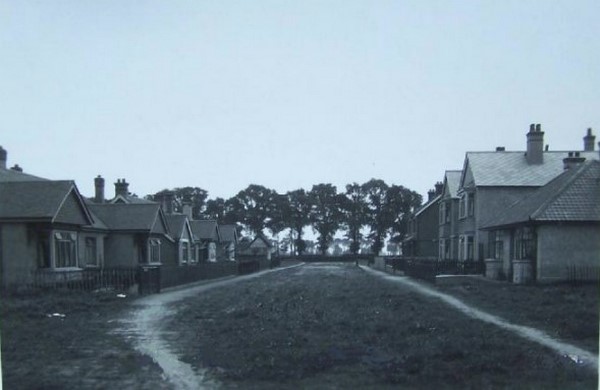
The south end of Manor Road circa 1929. The only other house in the road at the time would have been Coomehurst hence the left track curving away towards it and the one on the right heading straight down.
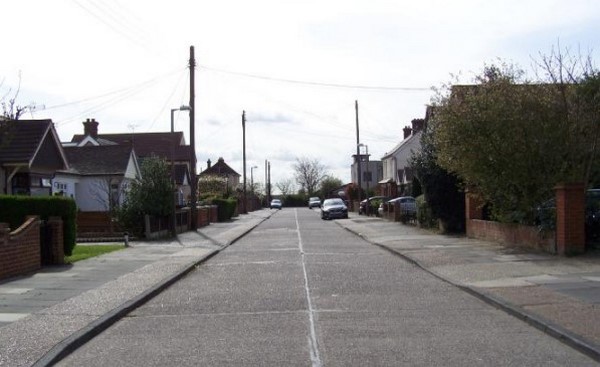
The view from the same spot in 2011.
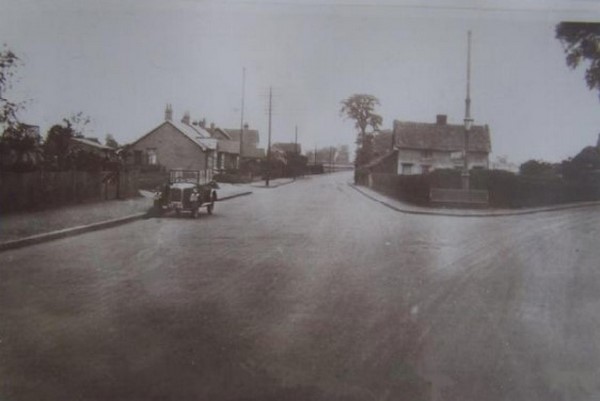
The junction of Corringham Road and Billet Lane circa 1930. The entrance to Manor Road is just visible on the left behind the (only!) car.
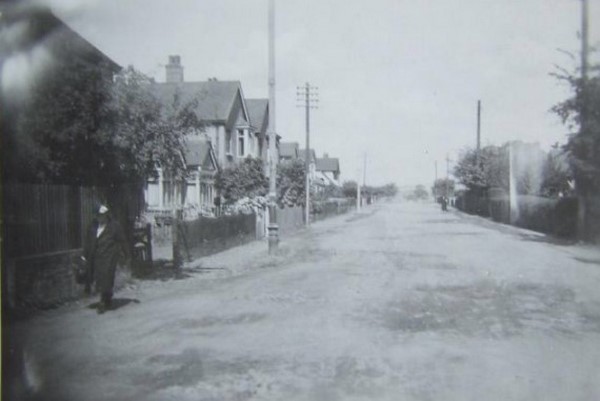
Manor Road looking north in the mid 1930s
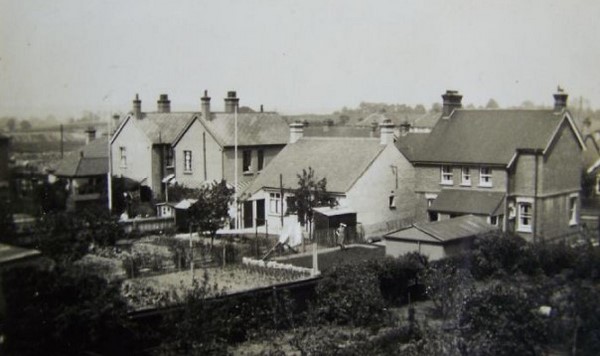
A view from the roof of ‘Beaufort’ Corringham Road in about 1935. Lily Wilding and Ivy Crickmer can be seen in their gardens.
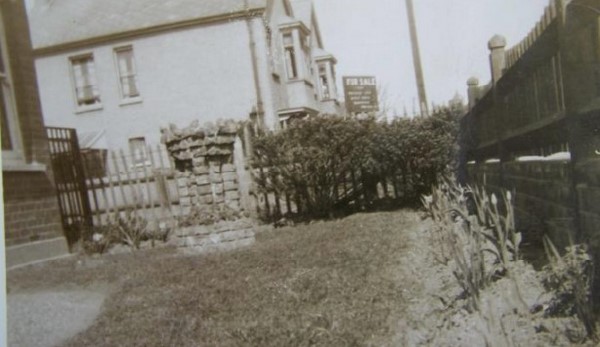
The front garden of Manor House in 1931. A sale board advertising the freehold plot where Sylvadene was later built is visible. The ornate structure in the front garden is a bird bath.
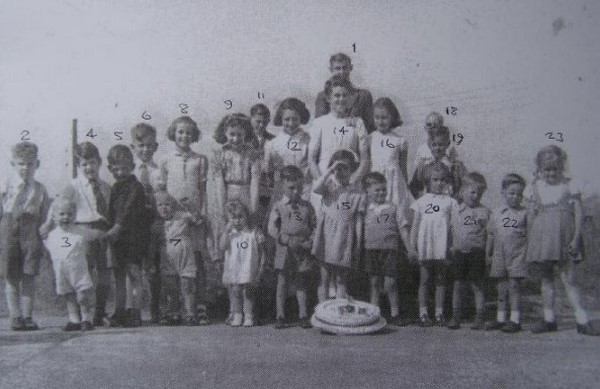
A VE (Victory in Europe) Childrens Party 1945
Manor Road appears to have sustained some damage during the Second World War as there are records of repairs having being made to cracked ceilings and walls with claims to the War Damage Commission under the War Damage Act 1941. There were a number of major air raids on the area during early 1941 with a parachute mine exploding on the corner of Corringham Road and Burgess Avenue on 8th April 1941 resulting in the deaths of nine people and the injury of several more with extensive damage to housing in the vicinity including the Rainbow Stores. In the appendix to this account, Mrs Judith Laugharne recalls playing in a bomb crater in the area.
VE day, on which the forces of Nazi Germany formally surrendered to the Allies, was May 8th 1945. The cessation of hostilities was a signal for tremendous celebrations throughout the country. Many street parties were quickly arranged including one for the road’s children along with those from Barstable Road and Hassingbrook (now Hassenbrook) Road organised by Connie Hardy; Lily Wilding; and Ellen Youngs of Barstable Road. The party was actually held in the grounds of the drill hall in Corringham road, now the East Thurrock Community Association.
In the picture are: 1- Peter Tongeman from Hay Tor Barstable Road; 2- Ronnie Wilding from Manor House; 3- Paul Deed from Glenhurst Barstable Road; 4- Peter Deed from Glenhurst Barstable Road; 5- Mervin Ward from Phylandi ; 6-John Hunting from Hassingbrook Road; 7- Paul King’s brother from Barstable Road ; 8- Joan Youngs from Salruc Barstable Road; 9- Mary Crickmer from Soulby; 10- Janice Crickmer from Soulby 11- John Wagstaff from Greenwayes 12- Sheila Woodall from Michaelstone, Hassingbrook Road; 13- Kelvyn Brabyn from Mowgli Barstable Road; 14- Sylvia Hardy from Sylvadene; 15- Unknown girl – possibly Judith Shade from Editha; 16- Ann Gurteen from Berlandale Barstable Road; 17- Unknown little boy – possibly Barrie Shade from Editha; 18- Peter King from Barstable Road; 19- John Youngs from Salruc Barstable Road; 20- Mary Gurteen from Berlandale Barstable Road; 21; Unknown little boy 22; Tommy Tongeman from Hay Tor Barstable Road; 23 Valerie Strange from End House.
The cake was made by the Army cook stationed at Beaufort in Corringham Road this house having been requisitioned by the Army to accommodate officers stationed in Stanford-le-Hope.
My thanks and appreciation go to Mr John Green and Mr Mervin Ward for very kindly supplying the details in this section.


